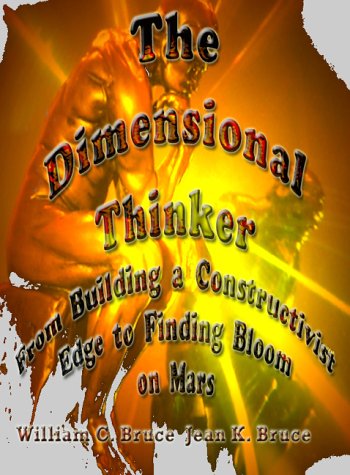Items related to The Dimensional Thinker: From Building a Constructivist...

Many people go mind numb when defining knowledge. Could you define knowledge by using more than memory? Move away from defining knowledge as something more than memory. Stir interest. Define knowledge by comprehension, application, analysis, synthesis, and evaluation. Need help? Blooms taxonomy is the Rosetta Stone for categorization of educational objectives. Blooms taxonomy is the key to the modern understanding of educational objective classification. To Professor Bruce, the question of how humans reached Mars looms as incredibly poignant. Explorers of Mars had to own a bank of creative processes. Did those creative processes exploit the cognitive domain? Do you believe categorizing educational objectives helps understanding? Would you say: categorizing educational objectives remains important? Is it important enough for educators to try to change the way we think about instructive taxonomy? The classification of concepts, in concert with the principles that bring about such classification, might loom as heavy thinking, if we stumble around without maps. Guidelines. Your mind's resourcefulness can develop better complex thinking processes. How? The proven principles guide you in this book. When? As multidimensional thinking objectives are presented. This book brings life to Blooms taxonomy through instruction, categorization exercises with feedback, glossaries, and assessments. Professor Bruce and Jean K. Bruce craft the variations on the different thinking level themes, called dimensions, and how the dimensions network. Whether inspired by the potential of your students, Mars exploration, or merely as a human survival affirmation, the text emphasizes how to use the categorization of educational objectives to build thinking skills. Those skills will take you beyond memory level to crazy-brilliant evaluation. 1. Educational characteristics in categorizing educational objectives 2. Higher thinking 3. Classifications of knowledge 4. Writing objectives 5. Curriculum development 6. Educational assessment 7. Educational taxonomy.
"synopsis" may belong to another edition of this title.
The Thomas Edison-like voice grew strong. Teaching strategies and thinking skills occupied the mind. Edison, now The Dimensional Thinker, said to me, "The rudder, propelling thinking skill development, often goes stock-still." I asked, "How can teachers expedite thinking skills?" The Thinker said, "Fall in love with diversity." As biodiversity conveys details about the variety of life, educational diversity conveys details about the variety of life knowledge. Example: An animal runs in front of your car. You’re unsure of its name. Your mind suffers until you find it. The clarification and naming of: people, places, things, events, and ideas open restricted access, to the art of gaining knowledge.
"About this title" may belong to another edition of this title.
- PublisherHome Tree Media
- Publication date2000
- ISBN 10 0970480105
- ISBN 13 9780970480101
- BindingCD-ROM
- Number of pages309
(No Available Copies)
Search Books: Create a WantIf you know the book but cannot find it on AbeBooks, we can automatically search for it on your behalf as new inventory is added. If it is added to AbeBooks by one of our member booksellers, we will notify you!
Create a Want